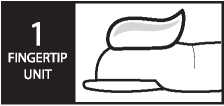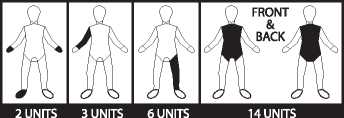Clobaderm 0.05% W/W Ointment

Auden Mckenzie
Group
Back cover 148mm
6. Further Information
What ClobaDerm contains:
The active ingredient is clobetasol propionate.
Each 1 g contains 0.5 mg of clobetasol propionate (0.05% w/w).
The other ingredients are:

• Cream: cetostearyl alcohol, glycerol monostearate, arlacel 165 (glycerol monostearate & macrogol 100 stearate), white beeswax, propylene glycol, chlorocresol, sodium citrate, citric acid monohydrate and purified water.
• Ointment: propylene glycol, sorbitan sesquioleate and white soft paraffin.
What ClobaDerm looks like and contents of the pack:
ClobaDerm Cream is a white or almost white cream.
ClobaDerm Ointment is an opaque ointment.
Within each carton is a tube with a plastic screw cap, which contains either 30 g or 100 g of cream or ointment.
Not all pack sizes may be marketed.
Marketing Authorisation Holder:
Auden Mckenzie (Pharma Division) Ltd., Mckenzie House, Bury Street, Ruislip, Middlesex, HA4 7TL, UK. Manufacturer:
Tiofarma B.V., Benjamin Franklinstraat 7-9, 3261 LW Oud-Beijerland, The Netherlands.
More Information
If you have any questions or are not sure about anything, ask your doctor or pharmacist who will advise you. Other sources of information are:
• National Eczema Society, Hill House, Highgate Hill, London, N19 5NA
• The Psoriasis Association, 2 Queensbridge, Northampton, NN4 7BF
• You may also be able to find out more from books in public libraries.
This leaflet was last revised in August 2012.
For information in large print, on tape, on CD or in Braille, phone +44 (0)1895 627 420.
P0109-110-11-01/3
O
Auden Mckenzie
T
Front cover 148mm
PATIENT INFORMATION LEAFLET
ClobaDerm® 0.05% w/w Cream & Ointment (Clobetasol Propionate)
Read all of this leaflet carefully because it contains important information for you.
• Keep this leaflet. You may need to read it again.
• If you have any further questions, ask your doctor or pharmacist.
• This medicine has been prescribed for you. Do not pass it on to others. It may harm them, even if their symptoms are the same as yours.
• If any of the side effects become serious, or if you notice any side effects not listed in this leaflet, please tell your doctor or pharmacist.
In this leaflet:
1. What is ClobaDerm and what is it used for?
2. Before you use ClobaDerm
3. How to use ClobaDerm
4. Possible side effects
5. Storing ClobaDerm
6. Further information
1. What is ClobaDerm and what is it used for?
ClobaDerm belongs to a group of medicines called steroids. It helps to reduce swelling and irritation.
ClobaDerm is used to help reduce the redness and itchiness of certain skin problems. These skin problems include eczema, psoriasis and dermatitis that have not responded to milder steroid creams or ointments.
2. Before you use ClobaDerm
Do not use ClobaDerm:
• if you are allergic (hypersensitive) to clobetasol propionate or any of the other ingredients of ClobaDerm (listed in Section 6)
• on a child under 1 year old
• to treat any of the following skin problems, it could make them worse:
• acne
• severe flushing of skin on and around your nose (rosacea)
• spotty red rash around your mouth (perioral dermatitis)
• itching around your back passage or private parts - unless your doctor has told you to do so
• viral infections, such as cold sores, herpes or chicken pox
• fungal infections, such as ringworm, athletes foot or thrush
• skin blisters or sores that are caused by an infection.
Do not use this medicine if any of the above apply to you. If you are not sure, talk to your doctor or pharmacist before using ClobaDerm.
Special Precautions:
Check with your doctor or pharmacist before using ClobaDerm if:
• you are applying the cream or ointment under an airtight dressing, including a child’s nappy. These dressings make it easier for the active ingredient to pass through the skin. It is possible to accidentally end up using too much cream or ointment.
• you have psoriasis, your doctor will want to see you more often.
If you are not sure if any of the above apply to you, talk to your doctor or pharmacist before using this medicine. Pregnancy and breast feeding:
Talk to your doctor or pharmacist before using this medicine if you are pregnant, might become pregnant or are breast-feeding.
Warnings about some of the ingredients:
ClobaDerm Cream contains cetostearyl alcohol which can cause local skin reactions (e.g. contact dermatitis), propylene glycol which may cause skin irritation and chlorocresol which may cause allergic reactions.
ClobaDerm Ointment contains propylene glycol which may cause skin imitation.
Inside spread - p2 148mm
3. How to use ClobaDerm
Always use ClobaDerm Cream or Ointment exactly as your doctor or pharmacist has told you. You should check with your doctor or pharmacist if you are not sure.
Using this medicine
• You usually apply a thin layer of ClobaDerm 1 or 2 times a day. This may be reduced as your skin begins to get better, or stopped when it is better.
• This cream/ointment is for use on your skin only.
• Do not use on large areas of the body for a long time (such as every day for many weeks or months).
If you need treatment for a long time, your doctor may decide you need to use a milder cream or ointment.
• The germs that cause infections like warm and moist conditions under dressings so always clean the skin before a fresh dressing is put on.
• If you are applying the cream or ointment on someone else make sure you wash your hands after use or wear disposable plastic gloves.
• If your skin problem does not improve in 2 to 4 weeks, talk to your doctor.
Guidance on how to apply the cream or ointment
1. Wash your hands.
2. Gently rub the correct amount of cream or ointment into the skin until it has all disappeared. You can measure how much ClobaDerm to use with your fingertip.

This picture shows one fingertip unit.
3. Unless you are meant to apply the cream or ointment to your hands as a part of the treatment, wash them again after using the cream or ointment.
For an adult:
You should find that:
• two fingertips of cream or ointment will cover both hands or one foot
• three fingertips of cream or ointment will cover one arm
• six fingertips of cream or ointment will cover one leg
• fourteen fingertips of cream or ointment will cover the front and back of the body.
Overall height 218mm
Do not worry if you find you need a little more or a little less than this. It is only a rough guide.

For a child:
• Do not use it on children under 1 year of age.
• The smaller the child the less you will need to use.
• A child of 4 years needs about a third of the adult amount.
• A course of treatment for a child should not normally last more than 5 days - unless your doctor has told you to use it for longer. The doctor may want to see the child every week, whilst using the cream or ointment.
If you have psoriasis
If you have thick patches of psoriasis on your elbows or knees, your doctor may suggest applying the cream or ointment under an airtight dressing. It will only be at night to help the cream or ointment to start working. After a short period of time you will then apply the cream or ointment as normal.
Y
Inside spread - p3 148mm
If you apply ClobaDerm to your face
You should only apply the cream or ointment to your face if your doctor tells you to. It should not be used for more than 5 days, as the skin on your face thins easily. Do not let the cream or ointment get into your eyes. If it does, wash it out with plenty of water.
If you use more ClobaDerm than you should
If, by mistake on a few occasions you use more than you should, do not worry. If you apply a lot or if a lot is accidentally swallowed, it could make you ill. Talk to your doctor or go to hospital as soon as possible.
If you forget to use ClobaDerm
If you forget to apply your cream or ointment, apply it as soon as you remember. If it is close to the time you are next meant to apply it, wait until this time.
If you stop using ClobaDerm
If you use ClobaDerm regularly make sure you talk to your doctor before you stop using it.
If you have any further questions on the use of this product, ask your doctor or pharmacist.
4. Possible side effects
Like all medicines, ClobaDerm can cause side effects, although not everybody gets them.
Stop using ClobaDerm and tell your doctor as soon as possible if:
• you find that your skin problem gets worse or your skin becomes swollen during treatment. You may be allergic to the cream or ointment, have an infection or need other treatment.
Other side effects you may notice when using ClobaDerm include:
• A feeling of burning, irritation or itching where the cream or ointment is applied.
• If you have psoriasis you may get raised bumps with pus under the skin. This can happen during or after the treatment and is known as pustular psoriasis.
Side effects if you use ClobaDerm for a long time, or you use a lot each time you apply it, or you apply it under an airtight dressing or a nappy:
• Stretch marks may develop.
• Veins under the surface of your skin may become more noticeable.
• Increased hair growth and changes in skin colour.
• Thinning of your skin that may also damage more easily.
• Weight gain, rounding of the face and high blood pressure. These are more likely to happen in infants and children.
If any of the above side effects are troublesome or last more than a few days or if you notice any side effects not mentioned in this leaflet, please inform your doctor or pharmacist.
5. Storing ClobaDerm
Keep all medicines out of the reach and sight of children.
Do not store above 30 °C.
Do not use the ClobaDerm after the expiry date (Exp xx/yyyy) which is shown on the tube and carton. The expiry date refers to the last day of that month.
This medicine should be disposed of 3 months after first opening.
Do not use the cream or ointment if any visible signs of deterioration, such as noticeable changes in colour are observed. If you are not sure please check with your pharmacist.
Medicines should not be disposed of via wastewater or household waste. Ask your pharmacist how to dispose of medicines that are no longer required. This will help to protect the environment.
continued on the other side